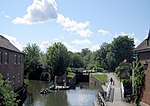Corn Exchange, Newbury
1862 establishments in EnglandArts centres in EnglandBuildings and structures in Newbury, BerkshireCommercial buildings completed in 1862Corn exchanges in England ... and 4 more
Grade II listed buildings in BerkshireMusic venues in BerkshireTheatres in BerkshireUse British English from April 2023

The Corn Exchange is an events and concert venue located in the Market Place in Newbury, Berkshire, England. The structure, which was commissioned as a corn exchange and is now used as an events venue, is a Grade II listed building.
Excerpt from the Wikipedia article Corn Exchange, Newbury (License: CC BY-SA 3.0, Authors, Images).Corn Exchange, Newbury
Market Place,
Geographical coordinates (GPS) Address External links Nearby Places Show on map
Geographical coordinates (GPS)
| Latitude | Longitude |
|---|---|
| N 51.4006 ° | E -1.323 ° |
Address
Corn Exchange
Market Place
RG14 5BD
England, United Kingdom
Open on Google Maps








